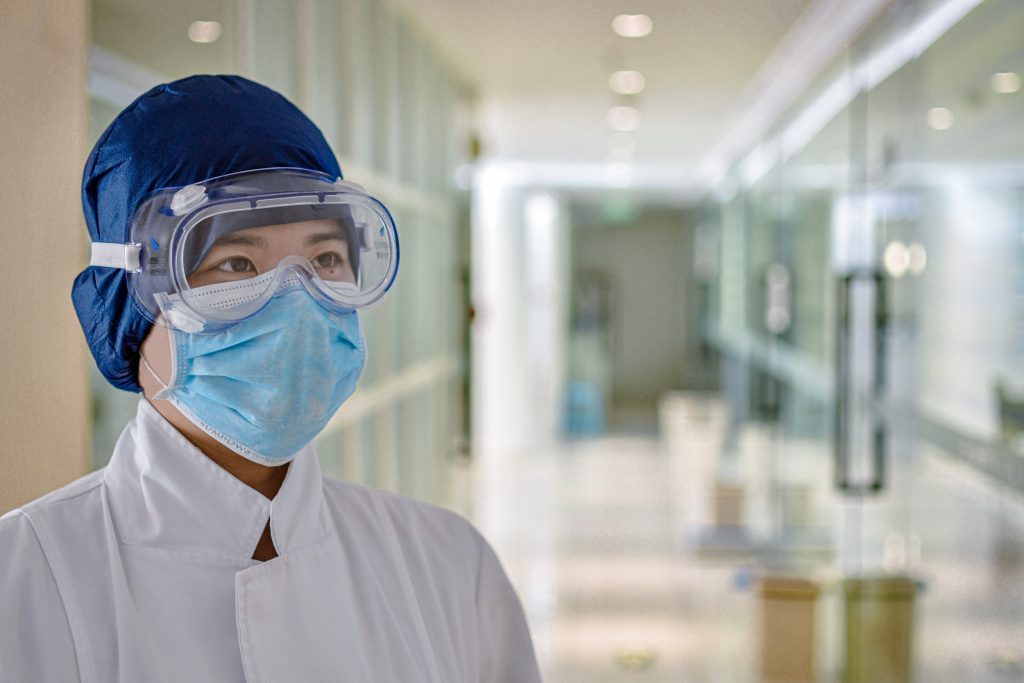PPE should protect eyes, nose and mouth

Roibeard O’hEineachain
Published: Friday, April 3, 2020
 The COVID-19 virus can survive as an aerosol suspended in the air and personal protection equipment (PPE) for healthcare professionals needs to protect all vulnerable surfaces on their body from infection, including mouth nose and eyes,, according to a recent report from China (Yu et al, Chinese Journal of Ophthalmology, 2020; DOI: 10.3760 / cma.j.cn112142-20200313-00181).
The authors note that from an aerodynamic perspective, particles with a diameter of 20μm or less are aerosols, and large droplets with a diameter greater than 20μm are droplets. The COVID-19 virus has a diameter of 60-to-140nm and can survive in the air. The severe acute respiratory syndrome (SARS) virus has more than 85% homology with COVID-19 and previous research has shown that SARS viral nucleic acid was detectable in the air of rooms with SARS patients.
The 2019-nCoV infects patients’ lungs by binding its “S” protein to angiotensin converting enzyme (ACE) II receptor in the pulmonary mucosa. Studies suggest that ACE II receptors are also expressed in human corneal and conjunctival tissues, raising the possibility of infection of these tissues by pathogenic aerosols.
The authors therefore advise that, to reduce the risk of infection, medical personnel should adopt a policy of wearing standardised personal protective equipment, wearing N95 masks or medical surgical masks and goggles. Patients should wear medical surgical masks to reduce the discharge of pathogenic droplets and aerosols.
Ophthalmologists have several special considerations to keep in mind when examining patients’ eyes. For example, when performing anterior eye and fundus examinations, the brightness of the light source of the slit lamp microscope and ophthalmoscope should be increased slowly to avoid the sneeze reflex. Moreover, fundus examination and gonioscopic examination can be replaced by fundus photography, anterior segment coherence tomography or ultrasound biomicroscopy.
In addition, ophthalmologists should reduce the frequency of inspections that are prone to produce pathogen aerosols, such as visual field inspection, and should avoid aerosol-producing tonometry techniques, the study’s authors advise.
The COVID-19 virus can survive as an aerosol suspended in the air and personal protection equipment (PPE) for healthcare professionals needs to protect all vulnerable surfaces on their body from infection, including mouth nose and eyes,, according to a recent report from China (Yu et al, Chinese Journal of Ophthalmology, 2020; DOI: 10.3760 / cma.j.cn112142-20200313-00181).
The authors note that from an aerodynamic perspective, particles with a diameter of 20μm or less are aerosols, and large droplets with a diameter greater than 20μm are droplets. The COVID-19 virus has a diameter of 60-to-140nm and can survive in the air. The severe acute respiratory syndrome (SARS) virus has more than 85% homology with COVID-19 and previous research has shown that SARS viral nucleic acid was detectable in the air of rooms with SARS patients.
The 2019-nCoV infects patients’ lungs by binding its “S” protein to angiotensin converting enzyme (ACE) II receptor in the pulmonary mucosa. Studies suggest that ACE II receptors are also expressed in human corneal and conjunctival tissues, raising the possibility of infection of these tissues by pathogenic aerosols.
The authors therefore advise that, to reduce the risk of infection, medical personnel should adopt a policy of wearing standardised personal protective equipment, wearing N95 masks or medical surgical masks and goggles. Patients should wear medical surgical masks to reduce the discharge of pathogenic droplets and aerosols.
Ophthalmologists have several special considerations to keep in mind when examining patients’ eyes. For example, when performing anterior eye and fundus examinations, the brightness of the light source of the slit lamp microscope and ophthalmoscope should be increased slowly to avoid the sneeze reflex. Moreover, fundus examination and gonioscopic examination can be replaced by fundus photography, anterior segment coherence tomography or ultrasound biomicroscopy.
In addition, ophthalmologists should reduce the frequency of inspections that are prone to produce pathogen aerosols, such as visual field inspection, and should avoid aerosol-producing tonometry techniques, the study’s authors advise.